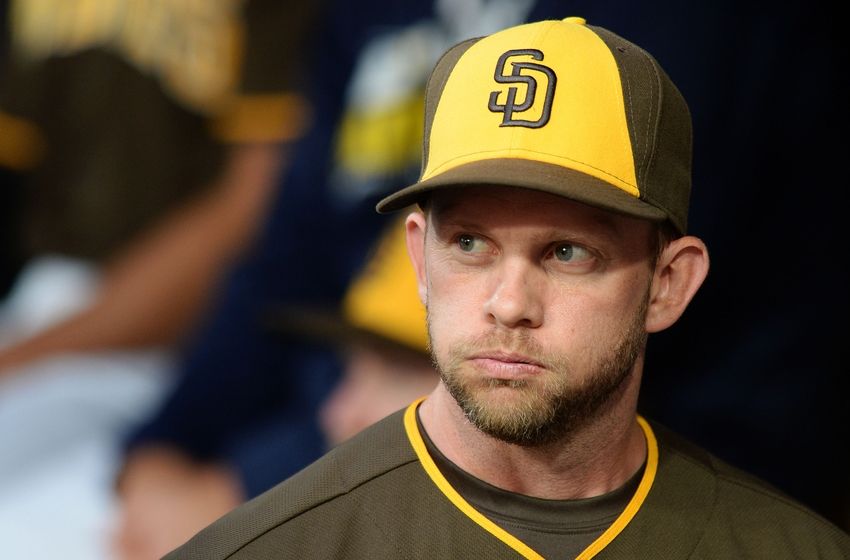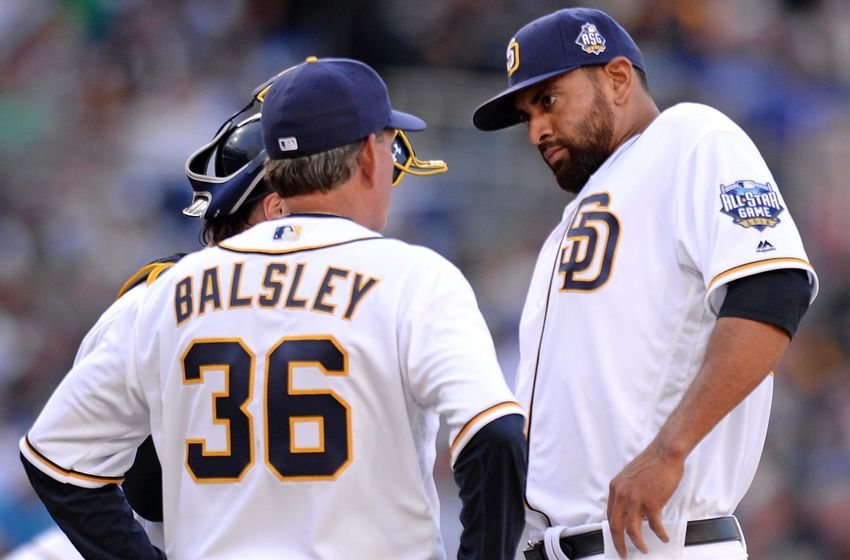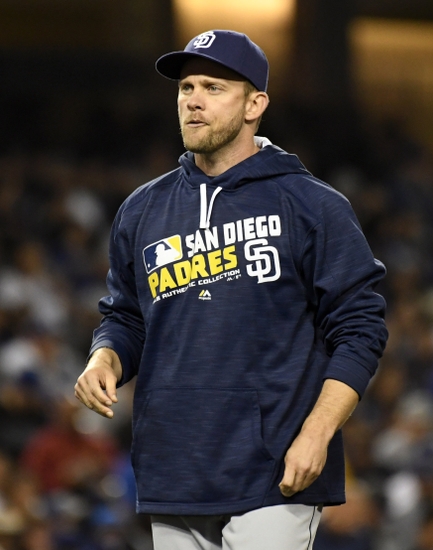Implementing a 3-Man Rotation Would Put Padres WAY Ahead of the Curve

Mandatory Credit: Jake Roth-USA TODAY Sports

Consistent Scheduling
By keeping both starters and relievers on a scheduled rotation, the TMR would avoid the question marks that often befall a bullpen. It will no longer be necessary for a reliever to warm up multiple times in a game, because his appearance will be predetermined based on the staff’s rotation. By limiting each pitcher’s appearance to just a handful of innings per game, a manager is also able to use his best pitchers more often (and possibly even every series) without expanding their weekly workloads. Furthermore, the TMR allows the entire pitching staff to operate on a typical starter’s schedule of off-days, bullpens, side sessions, and the like, developing a routine that should further contribute to the health benefits mentioned above.
Line-up Turnover
From a game manager’s perspective, the biggest benefit of the TMR is the ability to avoid facing line-ups a second or third time during a game. It makes sense that this would serve as a small step towards eliminating the advantage of familiarity for a hitter. Statistics from the 2015 season illustrate this point. The first time batters faced a pitcher on a given day, they collectively hit for a .247 batting average, a .312 on-base percentage, and a .390 slugging percentage. The second time through the order, hitters fared a little better, producing a triple-slash line of .261/.319/.416. The third time? Another noticeable improvement: .270/.330/.440.
One easy way to counteract this phenomenon is to restrict pitchers from facing hitters multiple times in a game (duh). Not only does this prevent hitters from getting comfortable at the plate and getting a better look at pitches out of the hand, it also removes some of the strategic limitations faced by starters in particular. In the early innings, it is common for starting pitchers to work with their A and B offerings, preserving their lesser offerings for later in the game. Operating with the knowledge that they don’t have to hold back on any of their stuff, a pitcher now has the ability to throw A, B, C, and D offerings whenever they want, a freedom that should result in greater variability from the mound and more guessing at the plate. Imagine watching the max-effort arsenals of up-and-coming Padres’ prospects like Chris Paddack and Anderson Espinoza without concerns for single-game longevity. Are you starting to drool now, too?
Budgetary Flexibility
For a smaller-market team such as the Padres, financial discussions are difficult to separate from conversations related to roster construction. The TMR allows for the monetary adaptability that the San Diego system consistently craves. Specific to the pitching staff, the front office will no longer be forced to give significant salaries to five starters on the basis of their innings contributions. In a world where Mike Leake can get a five-year, $80 million deal from the St. Louis Cardinals, finding an ability to avoid the rapidly inflating costs of major league starting pitching will be a boon for the Padres’ budget.
This can be done in favor of the middle-inning relief aces that refuse to become an appreciated commodity in the game of baseball. Head over to Fangraphs and take a look at the numbers of Will Harris of the Astros, Derek Law of the Giants, or, for those who can stomach the reminders, Matt Bush of the Rangers. Dream of the potential of Nationals’ righty Blake Treinen’s sinker (hint: it’s Britton-esque), or Giants’ righty Hunter Strickland’s high-90’s heat. They are all impressive to say the least, none of them are name-brand arms, and all but one currently make the major league minimum (Note: that one, Will Smith, only makes $1.5 million).

The money the team saves on pitching by employing such a strategy (even while potentially expanding the actual number of pitchers on the staff) will then be available to be redistributed to the offensive side of the roster. The suppressive ability of Petco Park’s not-so-friendly confines on a major league offense have been well-noted. Now, imagine having the financial firepower to pursue the league’s bonafide batting stars, stars that can tame the vast expanses of America’s most beautiful ballpark while putting fans in the seats (and then quickly pulling them to their feet with another scoring bout).
Suddenly, the Padres don’t have to search for under-the-radar gap-finders in attempts to manufacture runs. They’ll instead have the flexibility to pursue players that are actually good fits for the team’s home park. The dreamy but surprisingly realistic result? A stronger offense that can put up runs in support of a pitching staff built on fireballing filth and small amounts of cash.
The Secret Weapon
Finally, there’s this: the Padres have a potential luxury that no other team in baseball currently does. His name: Christian Bethancourt. His position: question mark? After seeing Bethancourt find surprising success in a few relief appearances in 2016, mixing high-90’s heat with developing off-speed offerings, the Padres are expressing an interest in turning the former full-time catcher into something resembling a hybrid baseballer not often seen past Little League. Hopefully following in the steps of fellow converted catchers such as Kenley Jansen, Jason Motte, and Troy Percival, the 25-year old will pitch in Panama this winter with the goal of developing a change-up and a sense of comfort on a mound in game situations.
Come 2017, he will definitely still catch and may get some playing time in the corner infield and outfield spots. However, if Bethancourt can find success on a major league mound consistently as well, he adds an extremely valuable Swiss army knife to the Padres’ collection of gunslingers. Working within the framework of the TMR, Bethancourt’s presence on the roster would mean an extra game-ready arm in the bullpen that doesn’t take the roster spot of an offensive contributor. Suddenly, the two often-disparate roles are one and the same in the body of the unprecedented and still-maturing Panamanian.
The Verdict
Between the financial flexibility offered by the TMR and the health and effectiveness advantages to its member, the idea is ultimately one with few downsides, allowing a team that is anticipated to simply play its way through much of 2017 anyway to evaluate a new system that could be at the forefront of baseball’s future.
There is no guarantee that the TMR will pay dividends for the hometown team. I’d be the first to admit that any move that flies in the face of long-standing baseball traditions should be looked at skeptically. But the Friars don’t have much to lose in a situation like this. If the TMR works like it appears it should, the Friars expedite their return to playoff contention. If not, the team finishes towards the bottom of the standings and lands a top 2018 draft pick, a result that is likely on the horizon anyway. Either way, Padres prospects get their work in and the organization’s rebuild continues.
In essence, only one real question remains then: why not?
Noah is a current undergraduate at the University of San Diego. In addition to his classes as a Business Economics student, Noah serves as the scouting director for the nationally-ranked USD baseball team and as an NFL correspondent with The Mighty 1090. You can follow him on Twitter @thebackseatlamp
What happens when some one has a bad outing and that messes up the “consistent scheduling”? There is absolutely zero chance that you could divide the innings up equally. Also you’re telling me that if you had a completely healthy Tyson Ross, who is easily the padres ace and would be at least a 2 or 3 on other teams, that you would tell him we know you’re good but hey we are only going to let you pitch 3 to 4 innings every two days? 1. That personally that sounds like more stress on an arm 2. You’re limiting your best asset who could literally single handedly win you 20 games (I’m assuming that’s 20 quality starts that the padres below average offense somehow wins). Also you are forgetting that relief pitchers are in the bullpen for a reason. They are meant to throw one inning stints as hard as they can. Look at the decline in Chapman and Miller towards the end of the playoffs and you want to extend that over a 162 game season? Good luck…Also good luck finding 9 copies of some of the best relief pitchers baseball. You’re think outside the box for sure but if this was such a great idea don’t you think someone would have done it already?
Sean, I do see your point, and I think that the limitations the system would put on a team’s best arms is one of the biggest potential drawbacks of the TMR. However, the Padres do not currently have any of those ace-level arms. Even Ross, with his history of success, is a risk considering the surgery he underwent in September for TOS, one that some have termed the new Tommy John because of the long-term question marks it creates. I think an argument could definitely be made for limiting his innings in the interest of staying healthy and prolonging his career. Also, in 2014, when Ross was a Cy Young contender and All-Star, he only won 13 games. I think locking him in for 20 is overly optimistic no matter what line-up is behind him. As for the Chapman-Miller fatigue argument, I believe it is a different situation because those guys were throwing multiple innings almost every day, and neither truly showed signs of fatigue until Game 7 of the World Series (i.e., Game 183 for the Cubbies and Game 180 for the Tribe). That’s not the kind of workload they’d be under in the regular season, where I propose them pitching in around a game per series. As far as the response to “meltdowns” by certain arms, I agree that a bad outing is all but certain on occasion, but that is compensated for by the inclusion of 2-3 additional guys that can be used either more flexibly or designated as the “emergency guy” going into a given game so a pitcher can still plan to pitch that day and the TMR rotation isn’t messed up. Finally, in regards to your final point, that sounds eerily similar to the initial backlash to the Moneyball movement. That is not to say that this is at all on par with the sabermetrics revolution, only to suggest that an idea not being fully implemented yet doesn’t necessarily restrict it from still being a good idea. Overall though, I wholeheartedly appreciate your comments and criticisms. I think a well-rounded approach is necessary to fleshing out any idea as fully as possible. No matter what the Padres do down the road, I think we can both agree that we hope that the Padres make some positive improvements in the near future. This town deserves a good ball club, and hopefully one day it can get one.
Noah (or should I call you Jed Junior?), this might be the best thing I’ve ever read on this site. Please give us more!
Thank you very much for the compliments, Brian! Keep your eye out for more content from Jed Junior in the future!